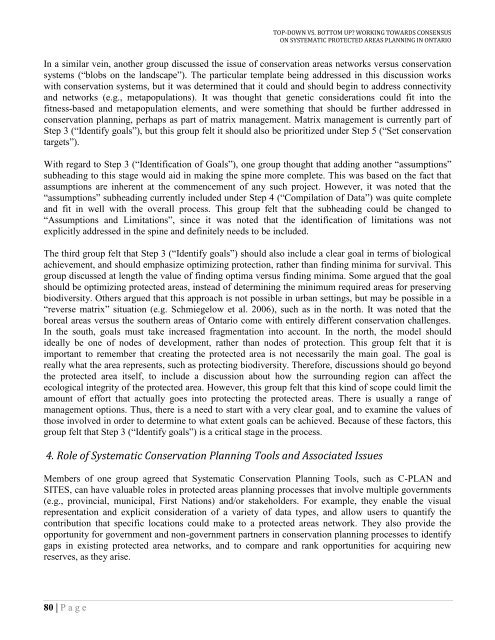Top-Down vs. Bottom Up: Working Towards Consensus ... - CASIOPA
Top-Down vs. Bottom Up: Working Towards Consensus ... - CASIOPA
Top-Down vs. Bottom Up: Working Towards Consensus ... - CASIOPA
- No tags were found...
Create successful ePaper yourself
Turn your PDF publications into a flip-book with our unique Google optimized e-Paper software.
TOP-DOWN VS. BOTTOM UP? WORKING TOWARDS CONSENSUSON SYSTEMATIC PROTECTED AREAS PLANNING IN ONTARIOIn a similar vein, another group discussed the issue of conservation areas networks versus conservationsystems (“blobs on the landscape”). The particular template being addressed in this discussion workswith conservation systems, but it was determined that it could and should begin to address connectivityand networks (e.g., metapopulations). It was thought that genetic considerations could fit into thefitness-based and metapopulation elements, and were something that should be further addressed inconservation planning, perhaps as part of matrix management. Matrix management is currently part ofStep 3 (“Identify goals”), but this group felt it should also be prioritized under Step 5 (“Set conservationtargets”).With regard to Step 3 (“Identification of Goals”), one group thought that adding another “assumptions”subheading to this stage would aid in making the spine more complete. This was based on the fact thatassumptions are inherent at the commencement of any such project. However, it was noted that the“assumptions” subheading currently included under Step 4 (“Compilation of Data”) was quite completeand fit in well with the overall process. This group felt that the subheading could be changed to“Assumptions and Limitations”, since it was noted that the identification of limitations was notexplicitly addressed in the spine and definitely needs to be included.The third group felt that Step 3 (“Identify goals”) should also include a clear goal in terms of biologicalachievement, and should emphasize optimizing protection, rather than finding minima for survival. Thisgroup discussed at length the value of finding optima versus finding minima. Some argued that the goalshould be optimizing protected areas, instead of determining the minimum required areas for preservingbiodiversity. Others argued that this approach is not possible in urban settings, but may be possible in a“reverse matrix” situation (e.g. Schmiegelow et al. 2006), such as in the north. It was noted that theboreal areas versus the southern areas of Ontario come with entirely different conservation challenges.In the south, goals must take increased fragmentation into account. In the north, the model shouldideally be one of nodes of development, rather than nodes of protection. This group felt that it isimportant to remember that creating the protected area is not necessarily the main goal. The goal isreally what the area represents, such as protecting biodiversity. Therefore, discussions should go beyondthe protected area itself, to include a discussion about how the surrounding region can affect theecological integrity of the protected area. However, this group felt that this kind of scope could limit theamount of effort that actually goes into protecting the protected areas. There is usually a range ofmanagement options. Thus, there is a need to start with a very clear goal, and to examine the values ofthose involved in order to determine to what extent goals can be achieved. Because of these factors, thisgroup felt that Step 3 (“Identify goals”) is a critical stage in the process.4. Role of Systematic Conservation Planning Tools and Associated IssuesMembers of one group agreed that Systematic Conservation Planning Tools, such as C-PLAN andSITES, can have valuable roles in protected areas planning processes that involve multiple governments(e.g., provincial, municipal, First Nations) and/or stakeholders. For example, they enable the visualrepresentation and explicit consideration of a variety of data types, and allow users to quantify thecontribution that specific locations could make to a protected areas network. They also provide theopportunity for government and non-government partners in conservation planning processes to identifygaps in existing protected area networks, and to compare and rank opportunities for acquiring newreserves, as they arise.80 | P a g e


